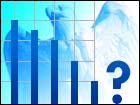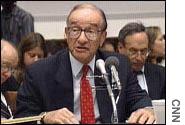|
Fed set to sit tight
|
 |
January 28, 2002: 12:24 p.m. ET
Data, Greenspan comments have economists expecting Fed inaction.
By Staff Writer Mark Gongloff
|
NEW YORK (CNN/Money) - Federal Reserve policy makers are scheduled to meet to discuss interest rates on Tuesday and Wednesday but are not expected to take any action, ending one of the most aggressive rate-cutting campaigns in the U.S. central bank's history.
The Fed cut its target for short-term rates 11 times in 2001, a record for a calendar year, to fight the effects of a recession that likely began in March, according to the National Bureau of Economic Research, and was worsened by the Sept. 11 terror attacks.
But recent signs that the labor market, consumer spending and manufacturing are stabilizing have led many economists to believe the Fed's rate-cutting days are over. The manufacturing sector, in particular, has been hard hit by the downturn.
Last week's cheery comments by Fed Chairman Alan Greenspan, explicitly designed to contradict an apparently gloomier outlook delivered on Jan. 11, cemented the idea that the Fed will leave rates alone this week.
"With the economy showing signs of life, the Fed easing cycle is probably at an end," Merrill Lynch chief economist Bruce Steinberg said. "We expect the Fed to hold steady."
The implied yield on federal funds futures contracts - often an accurate predictor of what the Fed will do with rates - anticipates the central bank will leave its target for the federal funds rate unchanged at 1.75 percent.
If the Fed does surprise the markets and cut rates again, it will do so to insure that a nascent recovery springs fully to life. In fact, just a week or so ago, most people thought the Fed was likely to cut again, in light of less-than-enthusiastic comments from Greenspan and other Fed officials.
Cautious economists agreed, saying the unusual strength in consumer spending during the recession was stealing growth from 2002 and watering down the recovery. A recent surge in consumer debt, they said, made a strong recovery even more unlikely.
"We have often noted the Fed tries to choose a policy action that minimizes the consequences of a mistake," said Wachovia Securities chief economist David Orr. "Which would have the least negative consequences today: easing too much and setting off an excessively strong rebound or easing too little and allowing the economy to slip back into recession? We would vote for the former."
The Fed manipulates interest rates to make borrowing easier when the economy is slow and to make borrowing costlier when it wants to stamp out inflation. If the rate-cutting campaign is nearly over, the next question is when the Fed will see the need to start raising rates again.
"We don't expect the Fed to tighten anytime soon," Merrill Lynch's Steinberg said. "The first tightening move is unlikely to occur before late summer at the very soonest."
Click here for more on the Fed and rates
The bond market disagrees; implied yields on fed funds futures expect the Fed to add a quarter percentage point to the fed funds rate after its May 7 meeting and think it could even add another quarter point at its June 25-26 meeting.
| |

|
|
Fed Chairman Alan Greenspan cooled hopes for a fiscal stimulus package last week. | |
One factor that could affect the next Fed cut is the possibility of an economic stimulus package from Congress. If lawmakers pass a bill that has a real impact on the economy, it could raise the risk of inflation more quickly.
On the other hand, Greenspan threw cold water on those crying for a stimulus package - including President Bush - by saying on Thursday that the economy would probably recover with or without one.
Investors will watch Bush's State of the Union address Tuesday to learn about his plans for a stimulus package, tax cuts and other government initiatives. But Bush is not likely to say much that will move financial markets - or Alan Greenspan.
"My guess is that he will try to work some surprises into the State of the Union message in order to get attention for it ... [but] those surprises won't be in the fiscal arena," said Julie Sedky, political analyst at Capital Insights Group. "My guess is they probably won't move the markets one direction or another. They will sift whatever he says through a reality test."
For example, Bush might say he wants a tax cut or some other perk for corporations, which have been "sort of a left-out constituency" so far in the Bush presidency, Sedky said. But, in light of the messy collapse of Enron Corp. and disappearing budget surpluses, Bush is unlikely to win any substantial prizes for businesses, especially in an election year.
Watching the bias
Investors will pay closer attention to the statement accompanying Wednesday's decision about rates for clues about the Fed's future actions. Since Dec. 19, 2000, the Fed has consistently said it thought the risks to the economy were weighted mainly toward economic weakness rather than inflation. If that "bias" changes, it could have as much impact as any rate action.
"It's probably a bit early to change the bias to neutral," said Robert MacIntosh, chief economist at Eaton Vance Management. "I suspect they'll say there's still more risk of another downturn than there is for too much of an upturn. Maybe the next meeting is when you have them take away the cutting bias."
One factor guiding the Fed's actions this year will be the unemployment rate. Job cuts make consumers nervous, and consumer spending fuels two-thirds of the economy. Keeping them happy with low interest rates could be a priority for the central bank.
The Labor Department's report on January unemployment and job cuts is due Friday, after the Fed makes its decision. Economists surveyed by Briefing.com expect unemployment to creep up to 5.9 percent from 5.8 percent in December, but they expect job cuts to fall to 50,000 from 124,000 in December.
"Our research shows the jobless rate is the best indicator of monetary policy," said Sung Won Sohn, chief economist at Wells Fargo & Co. "They have almost perfect correlation."
Since the unemployment rate will likely stabilize in the middle of the year, Sohn said, the Fed will likely change its rate-cutting bias at about the same time, paving the way to begin raising rates again later in the year.
On the other hand, the Fed could be inclined to keep rates low as an insurance policy against unexpected weakness or an overly sluggish recovery.
"The [economic] growth rate will be so weak, combined with extremely good inflation numbers, that I just don't see them doing anything in 2002," said Eaton Vance's MacIntosh. 
|
|
|
|
|
|

|

